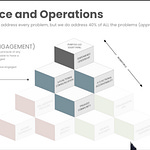This is a case study about a company that, from the outside, looked like a massive success. Growth was strong, leadership was inspiring, and employees were energized by a clear mission. Leadership saw a company on an upward trajectory. They believed their people, processes, and leadership were aligned and working as one. Revenues were still growing, and the few symptoms that employees raised were passed off as normal growth pains. But on the ground, employees were experiencing something quite different. By the time leadership recognized the problem, it had already taken a toll.
Silos had formed. Marketing wasn't aligned with sales leading to mismatched customer expectations and over-promised features that honestly didn't even exist. Cross-functional teams weren't working together because in reality, they weren't talking at all. KPIs weren't shared across teams, so success was being measured differently in every single department.
And the company's growth strategy shifted month to month, causing confusion and instability. Employees were frustrated, overwhelmed, and the negative energy was spreading quickly across the organization. Revenue had plummeted by 15%. The company was being forced to lay off about 65% of its workforce. And what once seemed like an unstoppable growth trajectory was now in free fall.
And without measuring, leadership had no idea why these issues were surfacing and where they needed to focus their efforts to fix them. Things seemed like they had sort of spiraled out of control. And so in a last ditch effort to diagnose what went wrong, they conducted an assessment of the 11 indicators and the findings threw them for a bit of a loop. Empowered leadership was lacking. Employees were empowered. Instead, they were stuck in layers of red tape, unable to make critical decisions without executive approval. Collaborative KPIs were almost non-existent. Each department was defining success differently, leading to misalignment and competing priorities.
Cross-functional accountability was missing. Teams worked in isolation, and when projects stalled, no one took ownership. Aligned tech stacks were fragmented. Different teams used different tools without integration, creating inefficiencies in data silos. And cross-functional communication had collapsed. Instead of collaboration, leadership was focused on protecting their own domains.
With these insights in hand, leadership faced a choice. Continue down their current path or take the steps to strategically rebuild. They chose the latter. Starting with the foundations, they focused on aligning technology, meeting efficacy, and aligning growth. Instead of fragmented department-specific tools, a company-wide tech strategy was implemented, integrating systems and streamlining workflows.
Growth alignment stabilized, clear long-term company goals were set, and for the first time in years, they weren't shifting every quarter. Then they introduced collaborative KPIs, ensuring that every department was tracking success through the same lens. They implemented collaborative processes, ensuring that only validated products were marketed and sold, closing the gap between promise and delivery.
With the foundations in place, they were able to rebuild cross-functional accountability and communication. Silos came down, teams began working cross-functionally, ensuring collaborative processes will replace isolated decision-making. And to reach the pinnacle, they overhauled the leadership structure, empowering decision-making at all levels and ensuring teams have the autonomy to own their own work.
It wasn't easy. It took 18 months of disciplined effort, but today the company is no longer in free fall. They're climbing again, stronger, more resilient, and on their way back to being a market leader.
On the surface, your company might look like it's thriving, but the question is, is it truly efficient? Are the cracks already starting to form? The takeaway from this is that the ability to measure where your organization stands is the difference between a small course correction or a total collapse. You can't fix what you don't measure.
And if you wait too long, it might just be a little bit too late.
Visit: LucidORG.com for additional information










Share this post